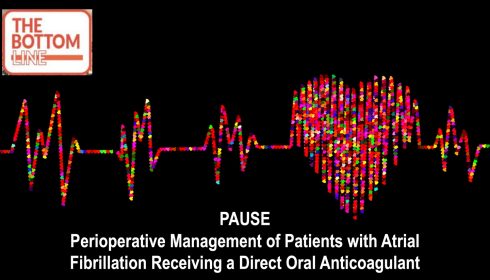STOP-IT
STOP-IT: Trial of Short-Course Antimicrobial Therapy for Intraabdominal Infection
Sawyers et al. N Engl J Med 2015: 372:1996-2005
Clinical Question
- In patients with intraabdominal sepsis and who have received adequate source control, does a fixed short course of antibiotics result in similar treatment success compared to a longer duration of antibiotic therapy?
Design
- Open-label
- Randomised in 1:1 ratio using a web-based data system
- Non-blinded clinicians
- Intention to treat analysis
- Aimed to recruit 1010 patients for 90% power to detect 10% difference in outcomes, assuming a 30% complication rate amongst the control group and assuming a drop out rate of 10%, at an alpha level of 0.05
Setting
- 23 sites throughout U.S and Canada
- August 2008- August 2013
- 517 patients
Population
- Inclusion:
- Complicated intraabdominal infection + intervention to achieve adequate source control + one or more of:
- temperature ≥ 38 C
- WCC ≥ 11,000/mm3
- gastrointestinal dysfunction due to peritonitis, precluding intake of more than half their normal diet (as an indicator of an ileus)
- Complicated intraabdominal infection + intervention to achieve adequate source control + one or more of:
Source control defined as any procedure (surgical or percutaneous drainage) aimed at stopping ongoing contamination of peritoneal cavity and removing majority of contaminated intraperitoneal contents to the extent that no further acute interventions are expected to be necessary
- 16 years or older
- Baseline characteristics: no statistical difference between the two groups
- mean APACHE II: 10.1
- mean age: 52 years
- organ of infective origin: colon or rectum (34%); appendix (14%); small bowel (17%)
- source control procedure: percutaneous drainage (33%); resection and anastomosis and closure (14%); surgical drainage only (21%)
- Exclusion:
- Lack of adequate source control decided by local investigator (LI) or principal investigator (PI = Robert Sawyer)
- High likelihood of death within 72 hours of initial intervention in opinion of LI or PI
- Planned re-laparotomy
- Several surgical pathologies
- Perforated gastric or duodenal ulcer treated within 24 hours of onset of symptoms
- Traumatic injury to bowel treated within 12 hours of injury (including iatrogenic)
- Non-perforated, non-gangrenous appendicitis or cholecystitis
- Gangrenous appendicitis or peritonitis without confirmatory cultures or with cultures without bacterial or fungal growth
- Ischaemic or necrotic intestine without perforation or positive microbial cultures
- Intraabdominal infection associated with active necrotising pancreatitis (although complications such as abscess or infected pseudocyst can be included)
- Primary/spontaneous bacterial peritonitis
- Intraabdominal infection associated with indwelling peritoneal dialysis catheter
- Primary skin closure of open surgical incision in the presence of diffuse non-localised peritonitis (other than closure of laparoscopy port)
- Pregnancy
- Concurrent infection requiring more than four days of antimicrobial therapy
Intervention – ‘short antibiotic course’
- Four full days of antimicrobial therapy after source-control procedure
- median duration of antibiotic therapy was 4 days (IQR 4-5)
Control
- Antimicrobials continued until two days after all of the following:
- Temperature < 38 C for one entire calendar day
- WCC < 11,000/mm3
- Ability to consume more than half normal diet
- Antimicrobials were continued for a maximum of ten days
- median duration of antibiotic therapy was 8 days (IQR 5-10)
In both groups, specific choice of antimicrobials were not dictated but were considered acceptable if they were consistent with the Surgical Infection Society and Infectious Diseases Society of America (SIS-IDSA) guidelines
Outcome
- Primary outcome: composite end point of surgical-site infection, recurrent intraabdominal infection requiring either surgical or percutaneous re-intervention and 30 day mortality
- No significant difference between the short antibiotic course group and the control group
- 21.8% vs 22.3%. Absolute risk difference (AD) of -0.5% (95% CI -7 to 8, p=0.92)
- No significant difference between components of composite outcome
- surgical site infection: AD -2.2%; 95% CI -2.4 to 7.0; P=0.43
- recurrent intraabdominal infection: AD 1.8%; 95% CI -4.5 to 7.8; P=0.67
- death: AD 0.4%; 95% CI -1.7 to 2.7; P=0.99
- No significant difference between the short antibiotic course group and the control group
- Secondary outcome: short antibiotic course group vs. control group
- Median duration of antimicrobial therapy for index infection
- 4 days vs 8 days, P=<0.001
- Median antimicrobial-free days at 30 days
- 25 vs 21, P=<0.001
- Median days in hospital after index procedure
- 7 vs 7, P=0.48
- Median Hospital free days at 30 days
- 22 vs 23, P=0.22
- Median duration of antimicrobial therapy for index infection
- No significant difference in rates of extraabdominal infection, Clostridium difficile infection, or infection with resistant pathogens
- Post-hoc analysis:
- No significant difference between groups in subgroup analysis of; patients treated per protocol (rather than intention), APACHE ≥ 10, healthcare-associated infections, surgical or percutaneous drainage, appendiceal and non-appendiceal source.
Authors’ Conclusions
- In patients with intraabdominal infections who had undergone an adequate source control procedure, the outcome after fixed-duration antibiotic therapy (approximately 4 days) were similar to those after a longer course of antibiotics (approximately 8 days) that extended until after resolution of physiological abnormalities.
Strengths
- Clinically relevant outcomes
- The study addresses a key component of antibiotic stewardship
- Exclusion criteria are appropriate; overall exclude patients who are unlikely to experience intraperitoneal infection, are unable to have source control (SBP and intraabdominal dialysis catheter), are likely to die before divergence of intended treatment course, or those in whom source control has not been achieved
- Groups well matched for demographics, comorbidities, index illness severity and interventions
Weaknesses
- This study was underpowered and halted at the interim analysis after recruiting half the planned patient numbers. Funding was discontinued because there was no difference in the groups at this stage.
- Whilst protocol adherence was reasonable (81.8% in the short course antibiotic group and 72.7% in the control group), small numbers and intention to treat analysis means that a difference between the two groups may have been missed
- There were significant delays in the diagnosis of surgical-site infection (15.1 vs 8.8 days) and recurrent intraabdominal infection (15.1 vs 10.8 days) in the control group as compared with the short antibiotic course group
- The definition of ileus is vague and causes for this are multifactorial and not always indicative of intrabdominal infection
- The median APACHE score and mortality was low and therefore may not be generalisable to the more critically unwell patients
- Samples for cultures were encouraged but not required
- Adequacy of source control was determined by the local investigator or principal investigator. A multidisciplinary approach involving the surgical +/- radiology specialists would have been preferable
- No data on antimicrobial-related adverse events
The Bottom Line
- An important study addressing antibiotic stewardship. In the UK, antibiotic courses are usually 5 – 7 days when adequate source control has been achieved. This study demonstrates that it might be reasonable to reduce this course even further in patients with low severity illness scores. Certainly in this underpowered study, prolonged courses of antibiotic therapy do not seem to have any additional benefit in this patient group
External Links
- [Article] Trial of Short-Course Antimicrobial Therapy for Intraabdominal Infection
- [Editorial] Antibiotics for abdominal sepsis
- [Podcast] STOP-IT Trial. NEJM
- [Further reading] Brief Antibiotic Course Effective for Gut Infections
- [Further Reading] National Emergency Laparotomy Audit
Metadata
Summary author: John Kiely and @SteveMathieu75
Summary date: 23 July 2015
Peer-review editor: @DuncanChambler



